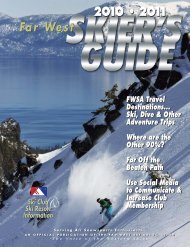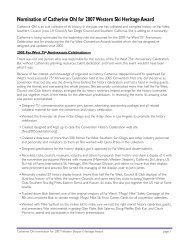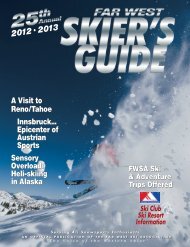▼ ▼ ▼ ▼ ▼Mahre, Austrian Petra Kronberger, Swiss VreniSchneider and Croatian Janica Kostelic, who eachhad 3 overall titles. Only Marc Girardelli of Luxembourg(5) and Annemarie Moser-Proell of Austria (6)have more overall titles. Also, for the season endingin 2012, Lindsey captured the following FIS WorldCup season long discipline titles: 5th downhill title,4th Super G title, and 3rd super combined title plusset the all-time women’s point total record with1,980. She added 12 FIS World Cup wins (Americanrecord) this season to reach a career total of 53which ranks 3rd all time among women behind AnnemarieMoser-Proell of Austria (62) and VreniSchneider of Switzerland (55) and 1st all time for theU.S. list ahead of Bode Miller (33) and Phil Mahre(27).■ Sixteen year old Mikaela Shiffrin (Vail, CO)earned her first FIS Alpine World Cup podium witha 3rd place at women’s slalom in Lienz, Austria inDecember 2011. She is the youngest female skier topodium in World Cup slalom since American TamaraMcKinney (1978). It has been more than two yearssince an American woman won a World Cup slalompodium (Lindsey Vonn in Levi, Finland).■ Utah & Vermont legislators make skiing andsnowboarding an official state sport in February2012 following the lead of Colorado in 2008.■ Canadian paralympian and X Games Mono<strong>Ski</strong>er X double medalist (2011 gold, 2012 bronze),Josh Dueck, completed the first back flip on a sit skiin February 2012 at Whistler, B.C.www.youtube.com/watch?v=4xjUUf_sK84■ Squaw Valley, CA opened world’s first skithroughStarbucks on the mountain at 8,000 feet inGold Coast mid-mountain complex in February 2012.www.flickr.com/photos/squawmedia/sets/72157629261178105/Safety Update■ Learn to <strong>Ski</strong> and Snowboard Month in January2012 had Glen Plake (3 time World Hot Dog <strong>Ski</strong>Champion, Down Home Tour ambassador), BodeMiller (5 Olympic medals, 2 overall World Cup titles,4 discipline titles), and Daron Rahlves (12 World Cupwins, 28 World Cup podiums, 7 U.S. National Titles)as the national ambassadors who communicated theexcitement and lifestyle benefits of snowsports participationand why it helps to take lessons from a prowhen starting out or trying to improve. The themewas “Humans were never meant to hibernate” withthe message “Bring a friend”. The 2012 estimatednumber of participants was 100,000, up from 75,000in 2011. www.<strong>Ski</strong>AndSnowboardMonth.org■ 1st Annual FIS World Snow Day – January 22,2012. The FIS World Snow Day goal was to encouragechildren with their families to enjoy and exploresnow while learning about the environment, healthbenefits of snow activities and safety on and off thesnow. The 225 events in 39 countries had over200,000 participants.The final report was released in June 2012 at:http://world-snow-day.com/en/WSD/Final_Report_2012.Photo summary video at:www.youtube.com/watch?v=YWP_ciwYDGo.2012.Video playlist from multiple Snow Day events:www.youtube.com/playlist?list=PL24DB714462BCA58C.The 2nd Annual World Snow Day will be1/20/13 with a goal of 500,000 participants.Taxation/Insurance/RiskManagement Update■ All tax exempt organizations are required tofile an annual return 990; or for those that qualify,an electronic notice 990-N to avoid the automaticrevocation of tax exempt status for organizationsthat fail to file for three consecutive years. The May17, 2010 deadline was imposed by the Pension ProtectionAct of 2006, which effectively required filingby almost all tax exempt organizations through theelimination of the old minimum annual revenue requirementfor filing of $25,000. IRS CommissionerDoug Shulman said that the IRS will be providingadditional guidance on how it will help these organizationsmaintain their important tax-exempt status,even if they missed the May 17 deadline. IRS CommissionerShulman urged these organizations to goahead and file, even though the May 17 deadline haspassed.www.irs.ustreas.gov/charities/index.htmlCheck with your club treasurer about yourclub’s filing status or look up your club in the form990 online databases such as:www. guidestar.org orhttp://nccsdataweb.urban.org/PubApps/990search.php/990search.php.Please note that it may take many months orlonger for the 990 forms to show up in these databasesand the databases are not always comprehensive.Transportation UpdateConsult the Checked Baggage policy sectionsof airline websites for further details and AirlineBaggage Rules article in the Travel section of thewww.fwsa.org website.■ United Airlines added daily, nonstop service toKelowna, British Columbia from Los Angeles, CAstarting this season 12/19/12.History Update■ U.S. <strong>Ski</strong> & Snowboard Hall of Fame Class of2011 inductees were named in November 2011, withthe induction ceremony held April 14, 2012 at Seattle’sBell Harbor Center. Inductees were: Joe Pack(2002 Olympic silver medalist, 3 World Cup wins, 12World Cup podiums, 2 World Championship bronzemedals), Eva Twardokens (1985 World Championshipbronze medalist, 3 World Cup podiums), Nick Badami(resort builder - Alpine Meadows, CA; Park City, UT;Powdr Corp), Phil Gravink (resort builder - Peak NPeek, NY; Gore Mountain, NY; Loon Mountain, NH);Mason Beekley (ski historian, International <strong>Ski</strong>ing History<strong>Association</strong> founder), Dick Dorworth (speed skierand author), Harry Leonard (ski show pioneer), TylerPalmer (2 World Cup wins, 4 World Cup podiums andpro ski racer).www.skihall.com/index.php?_a=document&doc_id=15 ▲▲Please see expanded article aboutHarry Leonard on page 41.New Additionsto the FWSA Rosterof Historic <strong>Ski</strong> Clubs■ Balboa <strong>Ski</strong> and Sports Club(1955) Newport Beach,California■ Idaho Falls <strong>Ski</strong> Club (1947)Idaho Falls, Idaho■ Longview <strong>Ski</strong> Club (1935)Longview, Washington■ Schnee Vogeli <strong>Ski</strong> Club (1942)Portland, Oregon■ Mt. Hood <strong>Ski</strong> Patrol (1937)Portland, OregonThe new designations areadded to the current list of clubsdesignated as Historic <strong>Ski</strong> Clubs.■ Cheyenne <strong>Ski</strong> Club (1949/59)Wyoming■ Fresno <strong>Ski</strong> Club (1934)■ Grindelwald <strong>Ski</strong> Club (1949)Los Angeles■ Sequoia <strong>Ski</strong> Club (1935)Visalia■ Single <strong>Ski</strong> Club ofLos Angeles (1960)■ <strong>Ski</strong>yente <strong>Ski</strong> Club (1955)PortlandLos Angeles (1942) and Bay Area(1942/45) Councils are eligible asHistoric <strong>Ski</strong> Councils.56 <strong>Far</strong> <strong>West</strong> <strong>Ski</strong>er’s Guide 2O12 - 2O13 / See the Digital Edition of the <strong>Far</strong> <strong>West</strong> <strong>Ski</strong>er’s Guide at www.fwsa.org.
<strong>Ski</strong>ing onGrassby Richard Lubin, D.C.“The SnowboardingChiropractor”Safety Committee Chair, FWSA<strong>Ski</strong>ing on grass. Am I referring to a newsummer sport? No, what I mean is people skiingwhile under the influence of marijuana.Does this present substantial risks? There isa shortage of research on this topic. The issueis conspicuous in its absence in this industry.So many participants and ski employees usecannabis regularly, that it is practically treatedwith a wink and a nod. I’m not suggestingthat intoxicated, aberrant, or poor behavior istolerated at ski resorts by their employees orpatrons. Marijuana use alone usually doesnot lead to boisterous ‘drunken’ type actions.California, the largest state by far, passedmedical marijuana laws in 1996 (Prop 215).The medical requirements are very lax. Thereare 17 states and the District of Columbiathat now have medical marijuana laws.Within the FWSA, that also includes Washington,Oregon, Nevada and Arizona. The illegalpurchase of the substance has been, andcontinues to be very popular and easy to obtain.In 2009, the Breckenridge, Colorado voterspassed a law allowing one ounce andparaphernalia by individuals over 21. Breckenridge<strong>Ski</strong> Resort (Vail Resorts) did not havethis same policy. Smoking weed among localsis so commonplace that it is implied. Mediaportrayal commonly shows skiers and snowboardersgetting high. The word Gondola hasbeen replaced by some with “Gangola”.Snowboarders are often characterized assmokers. The first time snowboarding was allowedat the Olympics, an incident occurred.Canadian snowboarder, Ross Rebagliati, wongold in men’s giant slalom at the 1998 Gamesin Nagano, Japan. He tested positive for marijuana,was stripped of his medal, and then, itwas given back. Since the inception of snowboarding,the “half pipe” has a double meaning.The widespread assertion that moresnowboarders smoke marijuana than skiersmay be true. The population of snowboarders,on average, is younger than the skiingpopulation. The younger population, skiers orboarders, are more likely to be users andchronic daily users, at that. In general, higherusage among the younger adult participantsin both of these sports is prevalent.Many states have legalized the use of medical marijuana. Thus, it has becomean ever increasing sight on the slopes. Few studies have been conducted on thesafety factors of smoking it while participating in snowsports, however, thegeneral opinion is that using cannabis increases the risk of injury. If not inplace already, ski resort policies will be reviewed to deal with this increasingtrend. photo by Richard LubinSO, IS IT DANGEROUS?Maybe! Among the scant safety dataavailable was an abstract published in theBritish Journal of Sports Medicine in 2009 basedon a study of trauma centers in Bern, Switzerland.Their findings investigated a number ofsafety issues. It was their opinion that manyfactors including cannabis use increases therisk of injury.A consideration in studying cannabis isthat there is a great degree of diversity in howit affects people. Generalizations as to its consequencesare more varied compared to otherdrugs. When people enjoy cannabis, they maynote the euphoric effects, or they may becomeparanoid and dislike the whole experience. Itaffects many parts of the brain including thehippocampus, which is important for shortterm memory and attentiveness. This distractibilitymay be an important safety risk.We do know that anything that affects yourattention and is a safety issue, just like textingand driving, is dangerous. It has also beenshown in some individuals, to affect reactiontime, coordination, and increase risk seekingbehavior. The heart rate may also increasedramatically. Those with cardiac issues needbe aware, notably since skiing takes place inrarefied air, already a risk factor.CONCLUSIONPeople will continue to use cannabis,since it has become easier to obtain, and thereare more powerful strains available. Amongthe population of skiers and snowboardersthere’s a substantial, but unknown, percentagethat use cannabis.Many of the locals in ski towns are particularlyavid users. They may be using on avery regular basis meaning daily or even multipletimes daily. This population may be leastaffected because of their proficiency level andfamiliarity with the intoxicating effects (habituation).At a high skill level with regularcannabis use, the risk may be no more thanwalking and chewing gum.Individuals at the lower skill levels likebeginners and intermediates, may be at thehighest risk. The occasional smoker may beoverwhelmed by the powerful effects. Commonplaceski skills may suddenly be a challengeand present peril.I am not making a judgment on whetheradults should or should not use cannabis. Myassessment is that it adds risk and requires extensiveinvestigation. Ignoring this topic is neglectful.An increasing populous will continueto smoke grass, will participate in snowsports,and this may lead to more injuries. If you doengage in this behavior, be especially vigilantand attentive. Each individual creates theirown risk management. Remember, safety isthinking first! ▲▲<strong>Far</strong> <strong>West</strong> <strong>Ski</strong>er’s Guide 2O12 - 2O13 57





